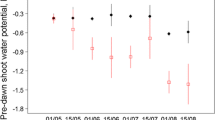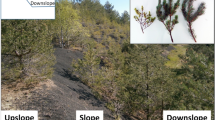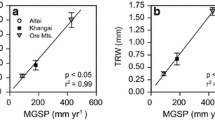Abstract
Widespread tree species must show physiological and structural plasticity to deal with contrasting water balance conditions. To investigate these plasticity mechanisms, a meta-analysis of Pinus sylvestris L. sap flow and its response to environmental variables was conducted using datasets from across its whole geographical range. For each site, a Jarvis-type, multiplicative model was used to fit the relationship between sap flow and photosynthetically active radiation, vapour pressure deficit (D) and soil moisture deficit (SMD); and a logarithmic function was used to characterize the response of stomatal conductance (G s) to D. The fitted parameters of those models were regressed against climatic variables to study the acclimation of Scots pine to dry/warm conditions. The absolute value of sap flow and its sensitivity to D and SMD increased with the average summer evaporative demand. However, relative sensitivity of G s to D (m/G s,ref, where m is the slope and G s,ref is reference G s at D = 1 kPa) did not increase with evaporative demand across populations, and transpiration per unit leaf area at a given D increased accordingly in drier/warmer climates. This physiological plasticity was linked to the previously reported climate- and size-related structural acclimation of leaf to sapwood area ratios. G s,ref, and its absolute sensitivity to D (m), tended to decrease with age/height of the trees as previously reported for other pine species. It is unclear why Scots pines have higher transpiration rates at drier/warmer sites, at the expense of lower water-use efficiency. In any case, our results suggest that these structural adjustments may not be enough to prevent lower xylem tensions at the driest sites.







Similar content being viewed by others
References
Addington RN, Donovan LA, Mitchell RJ, Vose JM, Pecot SD, Jack SB, Hacke UG, Sperry JS, Oren R (2006) Adjustments in hydraulic architecture of Pinus palustris maintain similar stomatal conductance in xeric and mesic habitats. Plant Cell Environ 29:535–545
Allen CA, Breshears DD (1998) Drought-induced shift of a forest-woodland ecotone: rapid landscape response to climate variation. Proc Natl Acad Sci USA 95:14839–14842
Antonova GF, Stasova VV (1993) Effects of environmental factors on wood formation in Scots pine stems. Trees 7:214–219
Beadle CL, Talbot H, Jarvis PG (1982) Canopy structure and leaf area index in a mature Scots pine forest. Forestry 55:105–127
Berninger F (1997) Effects of drought and phenology on GPP in Pinus sylvestris: a simulation study along a geographical gradient. Funct Ecol 11:33–42
Berninger F, Nikinmaa E (1997) Implications of varying pipe model relationships on Scots pine growth in different climates. Funct Ecol 11:146–156
Buckley TN, Roberts DW (2006) DESPOT, a process-based tree growth model that allocates carbon to maximize carbon gain. Tree Physiol 26:129–144
Cade BS, Noon BR (2003) A gentle introduction to quantile regression for ecologists. Front Ecol Environ 1:412–420
Callaway RM, DeLucia EH, Schlesinger WH (1994) Biomass allocation of montane and desert ponderosa pine: an analog for response to climate change. Ecology 75:1474–1481
Čermák J, Deml M, Penka M (1973) A new method of sapflow rate determination in trees. Biol Plant (Praha) 15:171–178
Čermák J, Kučera J, Nadezhdina N (2004) Sap flow measurements, integration within trees and scaling up from sample trees to entire forest stands. Trees 18:529–546
Ceulemans R, Kowalski AS, Berbigier P, Dolman AJ, Elbers J, Grelle A, Janssens IA, Lindroth A, Moors E, Rannik Ü, Vesala T (2003) Coniferous forests (Scots and Maritime pine): carbon and water fluxes, balances, ecological and ecophysiological determinants. In: Valentini R (ed) Fluxes of carbon, water and energy of European forests. Springer, Berlin Heidelberg New York, pp 71–98
Cochard H, Cruiziat P, Tyree MT (1992) Vulnerability of several conifers to air embolism. Tree Physiol 11:73–83
Cowan IR (1982) Water use and optimisation of carbon assimilation. In: Lange OL, Nobel CB, Osmond CB, Ziegler H (eds) Physiological plant ecology, vol 12B. Springer, Berlin Heidelberg New York, pp 589–630
Critchfield WB, Little EL (1966) Geographic distribution of pines of the world. USDA For Serv Misc Publ 991
Cunningham SC (2004) Stomatal sensitivity to vapour pressure deficit of temperate and tropical evergreen rainforest trees of Australia. Trees 18:399–407
DeLucia EH, Maherali H, Carey EV (2000) Climate-driven changes in biomass allocation in pines. Global Change Biol 6:587–593
Ewers BE, Gower ST, Bond-Lamberty B, Wang CK (2005) Effects of stand age and tree species on canopy transpiration and average stomatal conductance of boreal forests. Plant Cell Environ 28:660–678
Farquhar GD, Buckley TN, Miller JM (2002) Optimal stomatal control in relation to leaf area and nitrogen content. Silva Fenn 36:625–637
Gond V, de Pury DGG, Veroustraete F, Ceulemans R (1999) Seasonal variations in leaf area index, leaf chlorophyll, and water content; scaling-up to estimate fAPAR and carbon balance in a multilayer, multispecies temperate forest. Tree Physiol 19:673–679
González JA, Calbó J (2002) Modelled and measured ratio of PAR to global radiation under cloudless skies. Agric For Meteorol 110:319–325
Granier A (1985) Une nouvelle méthode pour la mesure du flux de sève brute dans le tronc des arbres. Ann Sci For 42:193–200
Granier A (1987) Evaluation of transpiration in a Douglas-fir stand by means of sap flow measurements. Tree Physiol 3:309–320
Granier A, Loustau D (1994) Measuring and modelling the transpiration of a maritime pine canopy from sap-flow data. Agric For Meteorol 71:61–81
Granier A, Biron P, Köstner B, Gay LW, Najjar G (1996) Comparisons of xylem sap flow and water vapour flux at the stand level and derivation of canopy conductance for Scots pine. Theor Appl Clim 53:115–122
Hacke UG, Sperry JS, Ewers BE, Ellsworth DS, Schäfer KVR, Oren R (2000) Influence of soil porosity on water use in Pinus taeda. Oecologia 124:495–505
Hacke UG, Sperry JS, Pockman WP, Davis SD, McCulloh KA (2001) Trends in wood density and structure are linked to prevention of xylem implosion by negative pressure. Oecologia 126:457–461
Irvine J, Perks MP, Magnani F, Grace J (1998) The response of Pinus sylvestris to drought: stomatal control of transpiration and hydraulic conductance. Tree Physiol 18:393–402
Irvine J, Law BE, Kurpius MR, Anthoni PM, Moore D, Schwarz PA (2004) Age-related changes in ecosystem structure and function and effects on water and carbon exchange in ponderosa pine. Tree Physiol 24:753–763
Jackson GE, Irvine J, Grace J (1995) Xylem cavitation in two mature Scots pine forests growing in a wet and a dry area of Britain. Plant Cell Environ 18:1411–1418
Jarvis PG (1976) The interpretation of the variations in leaf water potential and stomatal conductance found in canopies in the field. Philos Trans R Soc Lond B Biol Sci 273:593–610
Koenker R, Basset G (1978) Regression quantiles. Econometrica 46:33–50
Köstner B, Biron P, Siegwolf R, Granier A (1996) Estimates of water vapour flux and canopy conductance of Scots pine at the tree level utilizing different xylem sap flow methods. Theor Appl Clim 53:105–113
Köstner B, Falge E, Tenhunen J (2002) Age-related effects on leaf area/sapwood area relationships, canopy transpiration and carbon gain of Norway spruce stands (Picea abies) in the Fichtelgebirge, Germany. Tree Physiol 22:567–574
Lagergren F, Lindroth A (2002) Transpiration response to soil moisture in pine and spruce trees in Sweden. Agric For Meteorol 112:67–85
Lagergren F, Lindroth A (2004) Variation in sap flow and stem growth in relation to tree size, competition and thinning in a mixed forest of pine and spruce in Sweden. For Ecol Manage 188:51–63
Larcher W (2003) Physiological plant ecology, 3rd edn. Springer, Berlin Heidelberg New York
Leuschner C (2002) Air humidity as an ecological factor for woodland herbs: leaf water status, nutrient uptake, leaf anatomy and productivity of eight species grown at low or high vpd levels. Flora 197:262–274
Lundblad M, Lagergen F, Lindroth A (2001) Evaluation of heat balance and heat dissipation methods for sapflow measurements in pine and spruce. Ann Sci For 58:625–638
Luoma S (1997) Geographical pattern in photosynthetic light response of Pinus sylvestris in Europe. Funct Ecol 11:273–281
Lushnikov AA, Vesala T, Kulmala M, Hari P (1995) A semiphenological model for stomatal gas transport. J Theor Biol 171:291–301
Magnani F (2000) Carbon allocation and tree growth under hydraulic constraints in Scots pine (Pinus sylvestris L.). PhD thesis, University of Edinburgh, Edinburgh
Magnani F, Grace J, Borghetti M (2002) Adjustment of tree structure in response to the environment under hydraulic constraints. Funct Ecol 16:385–393
Maherali H, DeLucia EH (2000) Xylem conductivity and vulnerability to cavitation of ponderosa pine growing in contrasting climates. Tree Physiol 20:859–867
Maherali H, DeLucia EH (2001) Influence of climate-driven shifts in biomass allocation on water transport and storage in ponderosa pine. Oecologia 129:481–491
Maherali H, Williams BL, Paige KN, DeLucia EH (2002) Hydraulic differentiation of Ponderosa pine populations along a climate gradient is not associated with ecotypic divergence. Funct Ecol 16:510–521
Mäkelä A, Berninger F, Hari P (1996) Optimal control of gas exchange during drought: a theoretical analysis. Ann Bot 77:461–467
Marshall DC (1958) Measurement of sap flow in conifers by heat transport. Plant Physiol 33:385–396
Martínez-Vilalta J, Piñol J (2002) Drought-induced mortality and hydraulic architecture in pine populations of the NE Iberian Peninsula. For Ecol Manage 161:247–256
Martínez-Vilalta J, Sala A, Piñol J (2004) The hydraulic architecture of Pinaceae—a review. Plant Ecol 171:3–13
Martínez-Vilalta J, Vanderklein D, Mencuccini M (2007) Tree height and age-related decline in growth in Scots pine (Pinus sylvestris L.). Oecologia 150:529–544
McDowell N, Barnard H, Bond B, Hinckley T, Hubbard R, Ishii H, Köstner B, Magnani F, Marshall J, Meinzer F, Phillips N, Ryan M, Whitehead D (2002) The relationship between tree height and leaf area: sapwood area ratio. Oecologia 132:12–20
Meinzer FC (2002) Co-ordination of vapour and liquid phase water transport properties in plants. Plant Cell Environ 25:265–274
Meiresonne L, Sampson DA, Kowalski AS, Janssens IA, Nadezhdina N, Čermák J, Van Slycken J, Ceulemans R (2003) Water flux estimates from a Belgian Scots pine stand: a comparison of different approaches. J Hydrol 270:230–252
Mencuccini M (2003) The ecological significance of long-distance water transport: short-term regulation, long-term acclimation and the hydraulic costs of stature across plant life forms. Plant Cell Environ 26:163–182
Mencuccini M, Bonosi L (2001) Leaf/sapwood area ratios in Scots pine show acclimation across Europe. Can J For Res 31:442–456
Mencuccini M, Grace J (1995) Climate influences the leaf/sapwood area ratio in Scots pine. Tree Physiol 15:1–10
Molotkov PI, Patlaj IN (1991) Systematic position within the genus Pinus and intraspecific taxonomy. In: Giertych M, Mátyás C (eds) Genetics of Scots pine, vol 3. Elsevier, Amsterdam, pp 31–40
Mueller RC, Scudder CM, Porter ME, Trottter RTI, Gehring CA, Whitham TG (2005) Differential tree mortality in response to severe drought: evidence for long-term vegetation shifts. J Ecol 93:1085–1093
Nadezhdina N, Čermák J, Nadezhdin V (1998) Heat field deformation method for sap flow measurements. In: Čermák J, Nadezhdina N (eds) 4th International Workshop on Measuring Sap Flow in Intact Plants. IUFRO, Zidlochovice, Czech Republic, pp 72–92
New MG, Hulme M, Jones PD (1999) Representing 20th century space-time climate variability. I, Development of a 1961–1990 mean monthly terrestrial climatology. J Climate 12:829–856
Oleksyn J, Reich PB, Zytkowiak R, Karolewski P, Tjoelker MG (2003) Nutrient conservation increases with latitude of origin in European Pinus sylvestris populations. Oecologia 136:220–235
Oren R, Pataki DE (2001) Transpiration in response to variation in microclimate and soil moisture in southeastern deciduous forests. Oecologia 127:549–559
Oren R, Sperry JS, Katul GG, Pataki DE, Ewers BE, Phillips N, Schäfer KVR (1999) Survey and synthesis of intra- and interspecific variation in stomatal sensitivity to vapour pressure deficit. Plant Cell Environ 22:1515–1526
Palmroth S, Berninger F, Nikinmaa E, Lloyd J, Pulkkinen P, Hari P (1999) Structural adaptation rather than water conservation was observed in Scots pine over a range of wet to dry climates. Oecologia 121:302–309
Phillips N, Oren R (1998) A comparison of daily representations of canopy conductance based on two conditional time averaging-methods and the dependence of daily conductance on environmental factors. Ann Sci For 55:217–235
Piñol J, Sala A (2000) Ecological implications of xylem cavitation for several Pinaceae in the Pacific Northern USA. Funct Ecol 14:538–545
Poyatos R, Llorens P, Gallart F (2005) Transpiration of montane Pinus sylvestris L. and Quercus pubescens Willd. forest stands measured with sap flow sensors in NE Spain. Hydrol Earth Syst Sci 9:493–505
Rigling A, Bräker O, Schneiter G, Schweingruber F (2002) Intra-annual tree-ring parameters indicating differences in drought stress of Pinus sylvestris forests within the Erico-Pinion in the Valais (Switzerland). Plant Ecol 163:105–121
Ryan MG, Waring RH (1992) Maintenance respiration and stand development in a subalpine lodgepole pine forest. Ecology 73:2100–2108
Schäfer KVR, Oren R, Tenhunen JD (2000) The effect of tree height on crown level stomatal conductance. Plant Cell Environ 23:365–375
Schipka F, Heimann J, Leuschner C (2005) Regional variation in canopy transpiration of Central European beech forests. Oecologia 143:260–270
Stout DL, Sala A (2003) Xylem vulnerability to cavitation in Pseudotsuga menziesii and Pinus ponderosa from contrasting habitats. Tree Physiol 23:43–50
Sturm N, Köstner B, Hartung W, Tenhunen JD (1998) Environmental and endogenous controls on leaf- and stand-level water conductance in a Scots pine plantation. Ann Sci For 55:237–253
Sultan SE (2000) Phenotypic plasticity for plant development, function and life history. Trends Plant Sci 5:537–542
Swanson RH, Whitfield DWA (1974) A numerical analysis of heat pulse velocity: theory and practice. J Exp Bot 32:221–239
Tyree MT, Sperry JS (1989) Vulnerability of xylem to cavitation and embolism. Annu Rev Plant Physiol Plant Mol Biol 40:19–38
UNEP (1992) World atlas of desertification. Arnold, London
Wang Q, Tenhunen J, Dinh NQ, Reichstein M, Vesala T, Keronen P (2005) Similarities in ground- and satellite-based NDVI time series and their relationship to physiological activity of a Scots pine forest in Finland. Remote Sens Environ 93:225–237
Warren CR, McGrath JF, Adams MA (2001) Water availability and carbon isotope discrimination in conifers. Oecologia 127:476–486
Whitehead D, Jarvis PG (1981) Coniferous forests and plantations. In: Kozlowski TT (ed) Water deficits and plant growth. Academic Press, New York, pp 49–152
Whitehead D, Edwards WRN, Jarvis PG (1984a) Conducting sapwood area, foliage area and permeability in mature trees of Picea sitchensis and Pinus contorta. Can J For Res 14:940–947
Whitehead D, Jarvis PG, Waring RH (1984b) Stomatal conductance, transpiration, and resistance to water uptake in a Pinus sylvestris spacing experiment. Can J For Res 14:692–700
Whitehead D, Sherriff DW, Greer DH (1983) The relationship between stomatal conductance, transpiration rate and tracheid structure in Pinus radiata clones grown at different vapour saturation deficits. Plant Cell Environ 6:703–710
Zimmermann R, Schulze ED, Wirth C, Schulze EE, McDonald KC, Vygodskaya NN, Ziegler W (2000) Canopy transpiration in a chronosequence of Central Siberian pine forests. Global Change Biol 6:25–37
Acknowledgements
Research at the ICTJA was supported by the projects PROHISEM (REN2001-2268-C02-01/HID), PIRIHEROS (REN2003-08768/HID) and CANOA (CGL2004-04919-C02-01), funded by the Spanish MEC, and an agreement between CSIC and DGCONA within the RESEL project. The research at the University of Antwerp was in part supported by the Sixth Framework Programme of the European Commission as contract no. GOCE-CT-2003-505572 (Carbo-Europe IP) and by a Bilateral Scientific Cooperation project (BWS-BOF-2006) between the University of Antwerp and the Czech Republic. The first author benefited from a FPI grant and additional funding by the Spanish MEC for a research stay at the University of Edinburgh. We also acknowledge financial support from NERC (grant number NER/A/S/2001/01193) to M.Mencuccini. We would also like to thank two anonymous reviewers for their insightful comments on a previous version of the manuscript.
Author information
Authors and Affiliations
Corresponding author
Additional information
Communicated by Hermann Heilmeier.
Rights and permissions
About this article
Cite this article
Poyatos, R., Martínez-Vilalta, J., Čermák, J. et al. Plasticity in hydraulic architecture of Scots pine across Eurasia. Oecologia 153, 245–259 (2007). https://doi.org/10.1007/s00442-007-0740-0
Received:
Accepted:
Published:
Issue Date:
DOI: https://doi.org/10.1007/s00442-007-0740-0




